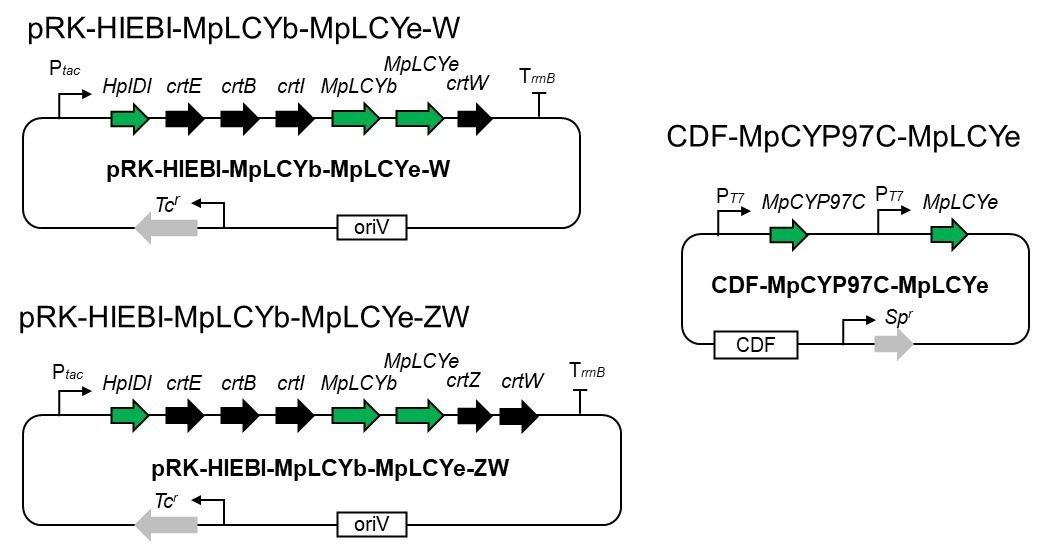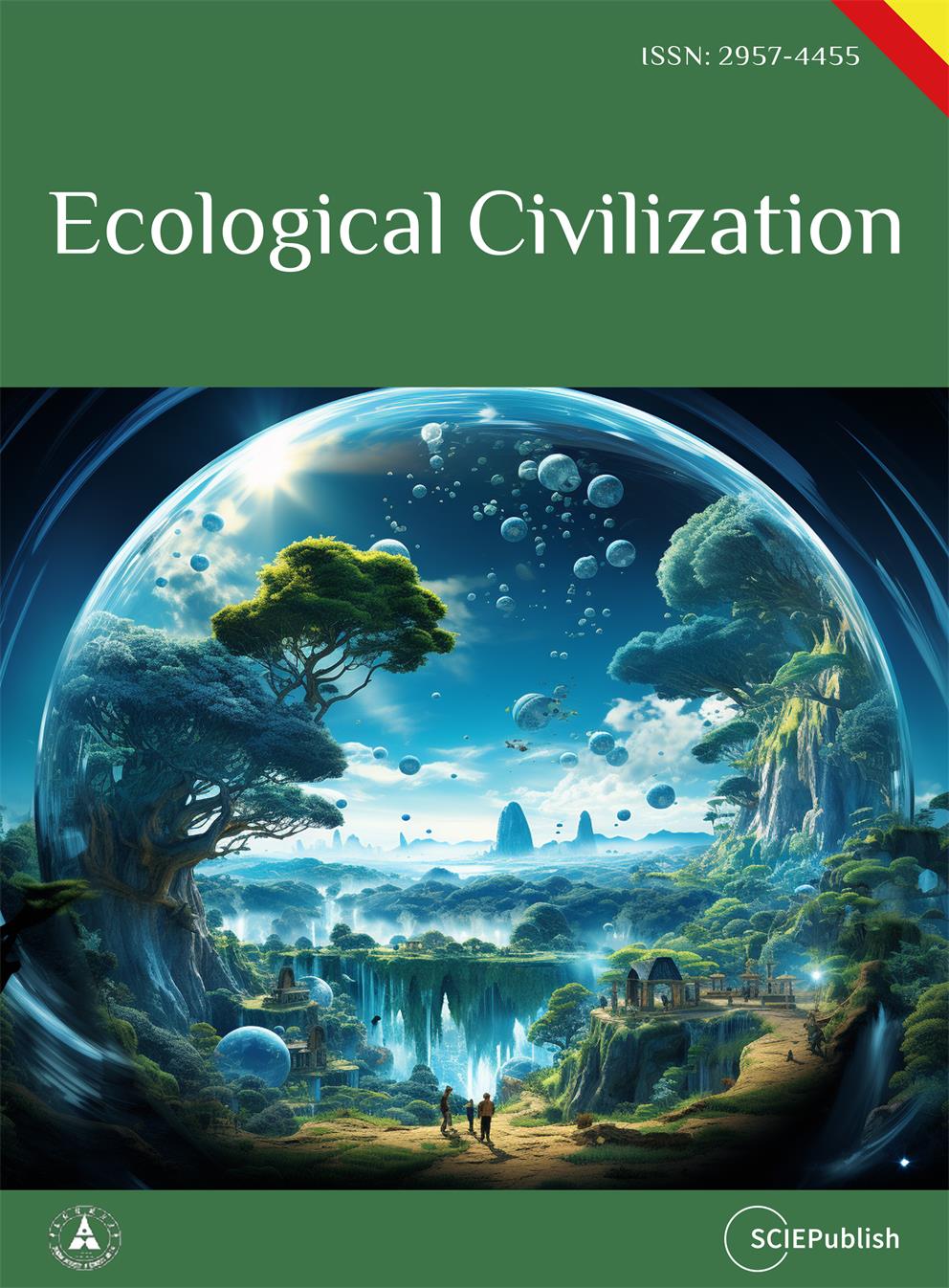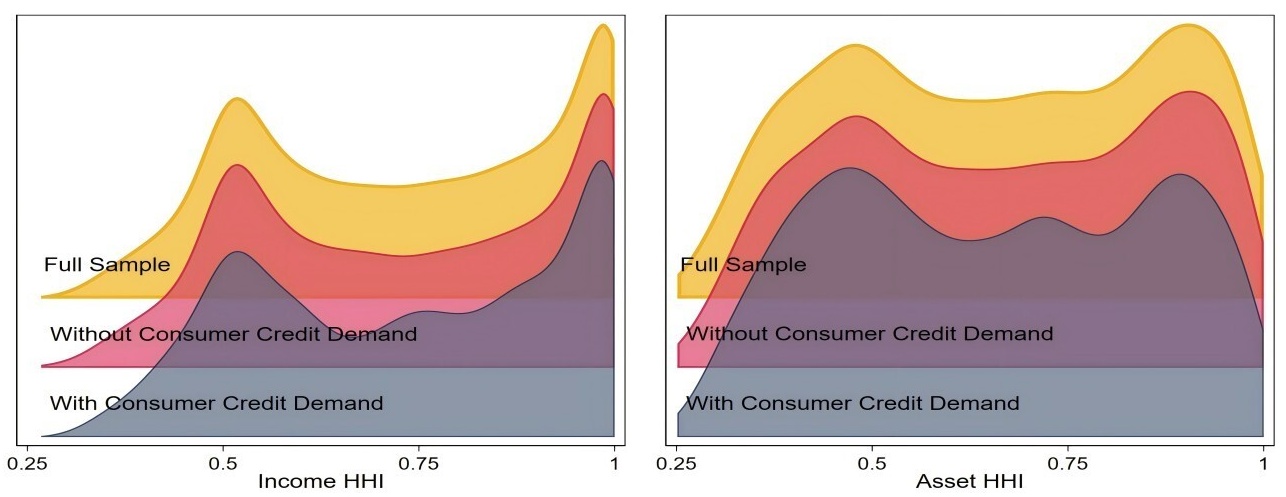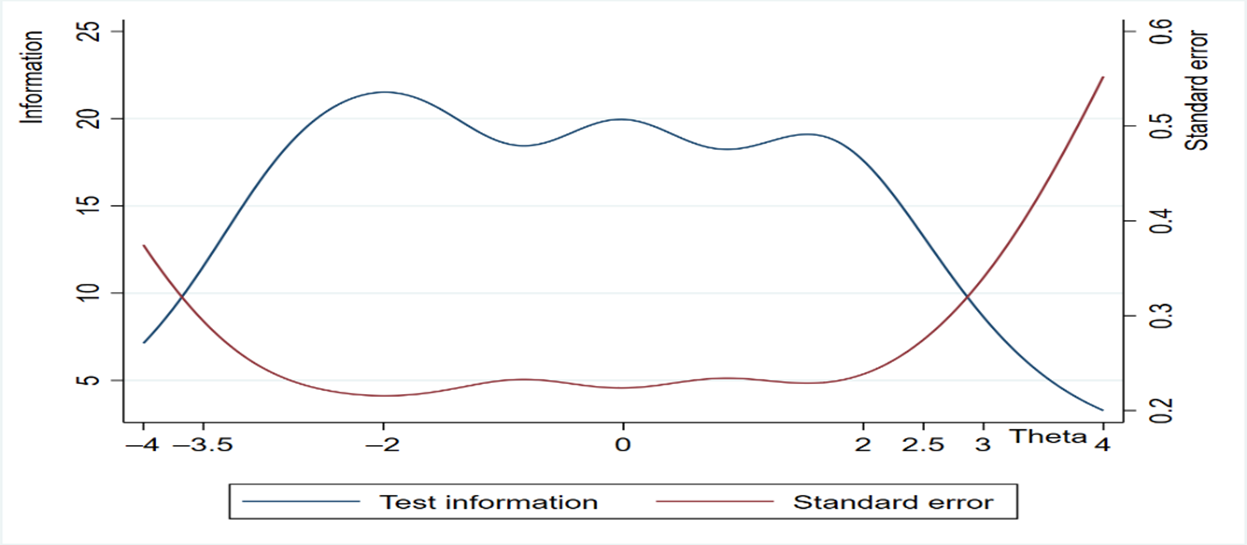Found 12 results
Article
03 December 2024Pathway Engineering of E. coli for Production of Fritschiellaxanthin and Other Carotenoids with α-Carotene Backbone and Their Singlet Oxygen-Quenching Activities
Some photosynthetic organisms are capable of biosynthesizing carotenoids (xanthophylls) with α-carotene backbone, that is, α-carotene-derived carotenoids, such as (3R,3′R,6′R)-3,3′-dihydroxy α-carotene (lutein). Except for lutein, such carotenoids are minor compounds in nature. In this study, α-carotene-derived carotenoids were produced with E. coli. To achieve this, carotenoid biosynthesis genes from the bacterium Pantoea ananatis containing the 4-β-ketolase (crtW) gene with/without the 3-β-hydroxylase (crtZ) gene, in addition to crtEBI genes, and biosynthesis genes (MpLCYb, MpLCYe, and MpCYP97C) from liverwort Marchantia polymorpha, along with the HpIDI gene, were cloned into plasmids. The transformed E. coli cells biosynthesized (3S,3′R,6′R)-3,3′-dihydroxy-4-keto-α-carotene (fritschiellaxanthin (4-ketolutein)), (3′R,6′R)-3′-hydroxy-4-keto-α-carotene (4-keto-α-cryptoxanthin), and (3′R,6′R)-3′-hydroxy-α-carotene (α-cryptoxanthin), as carotenoids that have not been produced by a heterologous microbial system so far. These carotenoids show potent singlet oxygen-quenching activity.

Article
18 November 2024Developing a Climate Litigation Framework: China’s Contribution to International Environmental Law
Although “climate litigation” is not an indigenous term in China, localizing it is essential to support the development of an independent environmental legal knowledge system in China. Rooted in China’s judicial tradition, which emphasizes substantive rationality, traditional legal theories have primarily focused on environmental law. However, the contemporary practices in the rule of law have created an unclear trajectory for climate litigation. Research in this area has long been trapped in a paradigm that relies on lawsuits for ecological environmental damage compensation and environmental public interest litigation, leading to a significant disconnect between theoretical framworks and practical application. With the advancement of the "dual carbon" strategic goals—carbon peaking and carbon neutrality—it has become imperative to redefine the concept of climate litigation within the Chinese context. We need to establish a theoretical framework that aligns with the “dual carbon” objectives while providing theoretical and institutional support for climate litigation, ultimately contributing to the international discourse on climate justice. Additionally, Hong Kong’s proactive climate governance and robust ESG (Environmental, Social, and Governance) practices provide valuable insights for developing comprehensive climate litigation mechanisms. Based on this analysis, we propose concrete plans for building a climate litigation system in China, establishing a preventive relief system and a multi-source legal framework at the substantive level and developing climate judicial mechanisms for mitigation and adaptation at the procedural level.

Article
04 November 2024Understanding Rural Consumer Credit Demand: Insights from China’s Household Income and Asset Structures
China’s ongoing supply-side structural reforms and the government’s strategic focus on rural revitalization catalyze a significant transformation in rural landscapes. The steady rise in rural residents’ incomes and assets, along with gradual improvements in household quality of life, is unlocking significant potential for growth and upgrades in the rural consumer market.This evolution necessitates a more diversified and sophisticated approach to financial services that is more inclusive and widespread. Despite the challenges, such as an aging population and imperfect credit systems that have limited the quality and precision of rural financial services, the analysis of household income and asset structures is vital for understanding consumption patterns and enhancing the economic vitality of rural households. Our study, based on the 2019 China Household Finance Survey data of 11,386 households and employing the Heckman two-stage model, finds that the proportions of income components and financial assets, moving in opposite directions, significantly influence the amount of consumer credit demanded, while other asset types, such as real estate, show no significant effect. The examination of income and asset diversity through the Herfindahl-Hirschman Index (HHI) demonstrates varying impacts of income and asset structures on credit demand, depending on the concentration levels of income and assets. Additionally, our analysis of heterogeneity based on the age of the household head and geographic region highlights the diverse influences on the amount of consumer credit demand, underscoring the importance of tailoring financial products and policies to meet the specific needs of rural households. These findings shed light on these dynamics and inform financial service innovations that align with the needs of rural consumers, thereby supporting the broader objectives of rural economic development and the achievement of China’s rural revitalization strategies.

Article
28 October 2024Challenges and Solutions: China’s Illegal Hunting Crime from the Perspective of Ecological Civilization Development
In recent years, the number of crimes involving illegal hunting in China’s judicial system has steadily increased, giving rise to numerous disputes. The root of these disputes lies in the fact that China’s Criminal Law lags in terms of animal protection legislation, failing to strike a balance between wildlife protection and human rights. This disconnection is particularly evident in the legislation and judicial practice regarding illegal hunting crimes and the value principles of ecological civilization strongly advocated by China. Moreover, China’s legal framework and judicial practices concerning illegal hunting crimes suffer from low thresholds for conviction and a lack of comprehensive investigations into the subjective intentions of offenders. Chinese legislators and judges should consider international experiences in combating illegal hunting crimes, elucidate the right to defend oneself against wildlife in certain dangerous situations, and thoroughly revise legal provisions, including the definition of illegal hunting and related judicial interpretations. Additionally, greater efforts should be made to disseminate public legal knowledge regarding illegal hunting crimes.

Article
14 May 2024Measurement and Structure of Common Prosperity of Urban Residents the Case of Hangzhou, China
Common prosperity is an important feature of the social state that the people of the world aspire to, and an important feature of the Chinese path to modernization. Taking common prosperity as the result of income and assets does not facilitate a full understanding of people’s common prosperity, because common prosperity also includes people’s pursuit of subjective happiness such as happiness and satisfaction. From the perspective of the need for a better life in China, this study constructs a subjective evaluation system of the common prosperity of urban residents, including 5 dimensions and 25 specific indicators. It uses survey data from 460 participants and applies the graded response models to estimate parameters and predict latent variables. We find that 21 indicators are in line with the reasonable range of basic assumptions and parameters. They have a strong ability to distinguish the common prosperity of residents in different regions, but have different functional characteristics. The confirmatory factor analysis shows that the common prosperity index of residents includes four potential factors: income, education, medical care, and old-age care, and ecology, which has a good structural effect. In terms of weight, education, medical care and old-age care are the most important factors influencing common prosperity. Among them, the classification policy of high school entrance examination, the quality and fairness of primary and secondary education, the degree of medical insurance security, and the waste sorting and community security are important aspects of evaluating the Common prosperity of residents.

Article
19 April 2024Can Digital Village Construction Reduce Rural Income Disparity?—Empirical Analysis Based on Inter-provincial Panel Data in China
Cutting the income disparity within rural areas is one of the key priorities in seeking common prosperity in China. Based on the panel data of 20 provinces in China from 2011 to 2020, we empirically analyze the impact of digital village construction on rural income disparity by building a digital village construction level indicator system which represents three dimensions of digitalization in rural areas, i.e., digitalization of rural infrastructure, digitalization of agricultural development and digitalization of rural residents’ life. Overall, the level of digital village construction in rural China has shown a development trend of gradual improvement, while the development level in various regions is unbalanced and varies greatly. The results of the fixed-effect model show that, digital village construction can significantly reduce the income disparity in rural areas, whereas the effect is significant in eastern China, insignificant in central and western China. It is recommended to increase the investment in funds and talents and take full consideration and advantage of local conditions, while promoting the development of new rural digital economy, so to achieve the development goal of common prosperity of rural residents.

Article
18 December 2023Measurement of Energy Poverty and Influencing Factors of Rural Households in China
Despite being the world’s largest developing country, China faces significant disparities between urban and rural areas, which exacerbates energy poverty in rural regions. This issue of energy poverty is a global concern, as millions of people lack access to modern energy necessary for a decent quality of life. This research aims to analyze the levels and structures of energy consumption in rural Chinese households, using data from the Chinese General Social Survey (CGSS) conducted in 2015 and 2018. The research employs the poverty line threshold and Theil index methods to comprehensively assess energy poverty in diverse regions. It also examines the economic, social, and familial factors influencing rural energy poverty. The findings reveal a transition in rural energy consumption towards cleaner sources, but energy poverty remains a significant issue. Factors such as energy prices and household size have a positive impact on energy poverty, while per capita income, education level, and social factors exert a negative influence.

Article
15 December 2023The Role of Liability Regime in Addressing Historical Contaminated Land Problems: A Comparative Perspective from England and China
This article conducts a comparative analysis of contaminated land regimes in China and England, focusing on their development, liability attribution, key principles, administrative nature, and financial guarantees. Both regimes are risk-based and are supported by the Polluter Pays Principle and the Stewardship Principle. They have similar liability arrangements: attributing the liability firstly to the polluter and then to landowners/occupiers or the usufructuaries. Administrative authorities under both regimes hold pivotal roles in remediating land on certain occasions. However, the cost recovery mechanisms vary due to the different constitutional roles among enforcing authorities, courts, and liable parties in the two countries. Both regimes impose retrospective liability, yet England provides detailed rules regarding the hardship provision and exclusion tests, preventing the unfair allocation of liability more effectively. Experience from England highlights the limited role of legal regimes in managing historical pollution, emphasising the need for supplementary mechanisms. This is why financial support is critical for effective land remediation in both countries.

Commentary
14 September 2023Synthetic Biology Industry in China: Current State and Future Prospects
In this article, we provided an overview of the current state of the SynBio industry in China with a focus on its research and technology, its main applications, and major players. We also discussed future prospects including the challenges and advantages of the SynBio industry in China.

Perspective
06 July 2023An Extremely Long Span of the Sun-Earth Pattern in the History of China
Chinese people believe that they are descendants of the prehistory Emperors Yan and Huang, while Yan (hot/red) and Huang (yellow) are the colors of the sun and earth. In the Dahecun style of Yangshao Culture archaeological culture of the legendary Yan and Huang’s period, the patterns of the sun and earth were frequently painted on the religious potteries, implying that the paired symbols might refer to the two emperors. However, the same paired pattern appeared in Shangshan Culture much earlier than Yangshao, indicating that the worship of Sun-Earth might have a quite long history prior to the two emperors. The pattern was inherited in the populations of China till today. The Jade Bi-Cong group of late Neolithic and early Bronze Age China also showed the same meanings and shapes. We found that the Sun-Earth pattern was quite common on the traditional brocade belts woven in the countryside around Shanghai. The origin of the sun shape was easy to understand, while that of the earth shape, a cross with or without an outline square, was hard to trace. Recent archaeological discovery in Shangshan Culture of a kind of yellow pyramid stone provided a new clue to the origin of earth symbol.
